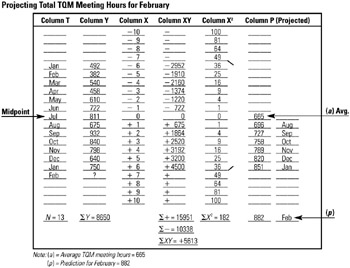Tool 205: Trend Analysis
| AKA | Time Series Analysis |
| Classification | Analyzing/Trending (AT) |
Tool description
Trend analysis tool can project, on the basis of historical data segments, the increase or decrease of what is being measured for the next time segment. Trend analysis is simply comparing performance data and calculating a projection that, if undesirable, may require immediate attention.
Typical application
-
To project future time segment data on the basis of time-series calculations.
-
To analyze performance data trends over time.
-
To show directionality and variability in measured data.
Problem-solving phase
| → | Select and define problem or opportunity |
| → | Identify and analyze causes or potential change |
| Develop and plan possible solutions or change | |
| Implement and evaluate solution or change | |
| → | Measure and report solution or change results |
| Recognize and reward team efforts |
Typically used by
| 1 | Research/statistics |
| Creativity/innovation | |
| 3 | Engineering |
| 2 | Project management |
| 4 | Manufacturing |
| Marketing/sales | |
| Administration/documentation | |
| Servicing/support | |
| 5 | Customer/quality metrics |
| Change management |
before
-
Data Collection Strategy
-
Checksheet
-
Observation
-
Line Chart
-
Timeline Chart
after
-
Starbursting
-
Action Plan
-
What-If Analysis
-
Cost-Benefit Analysis
-
Countermeasures Matrix
Notes and key points
-
Recommendation: Use at least nine time intervals of historical data to calculate the "next time interval" projection for costs, defects, time lost, time used, outputs, inventory, activities, events, or other performance measures.
-
Equations used to calculate a projection:

-
As calculated for the example shown:

Step-by-step procedure
-
STEP 1 As a preliminary step, the data collection process determines the specific performance data, the historical time period and number of time segments within, and the next time segment for which the projection is to be calculated.
-
STEP 2 An odd number of data scores (13 months in this example) is inserted into columns T and Y of the trend analysis worksheet. See example Projecting Total TQM Meeting Hours for February.
-
STEP 3 Column Y is multiplied by column X and the results inserted into column XY. Positive and negative totals are added, and the resultant total reflects the directionality of the trend. The respective values in column X2 (within the brackets) are also added.
-
STEP 4 The totals of all columns are used to calculate the average (a), the factor (b), and finally, the projection (Y') as shown in notes and key points.
-
STEP 5 A check is made by adding the factor (b) to the calculated average (a) in column P, as shown in this example. In this case, a repeated addition of 31 for each month (August-February) will result in a February projection of 882 as calculated with Y' a + bt. Note: t = 7, the number of segments for this calculation (July–January) as seen in column T. Ensure that the median data score is always placed in the midpoint position of column T in the trend analysis worksheet.
-
STEP 6 All calculations are verified for accuracy; the trend analysis worksheet is dated and attached to a report.
Example of tool application

EAN: 2147483647
Pages: 326
- Key #1: Delight Your Customers with Speed and Quality
- When Companies Start Using Lean Six Sigma
- Making Improvements That Last: An Illustrated Guide to DMAIC and the Lean Six Sigma Toolkit
- The Experience of Making Improvements: What Its Like to Work on Lean Six Sigma Projects
- Six Things Managers Must Do: How to Support Lean Six Sigma